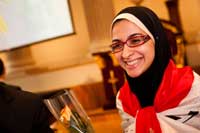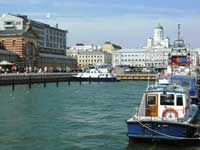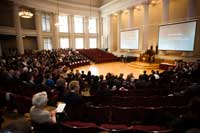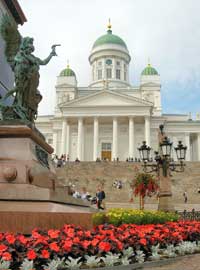Camp of brilliant brains Inspire article
Petra Nieckchen from EFDA reports on the 23rd European Union Contest for Young Scientists (EUCYS) in Helsinki, Finland.

winner of the EFDA-JET prize
Image courtesy of EUCYS
Sometimes even the richness of the English language is not enough. In their speeches describing participants at the European Union Contest for Young Scientists (EUCYS)w1, representatives of renowned institutions used words such as “bright”, “talented”, and “enthusiastic” tirelessly.
However, these are insufficient words to describe the young scientists who presented their work.

of the city
Image courtesy of Birgit Winter;
image source: pixelio.de
The perseverance and seriousness with which these 16- to 20-year-old students pursue their projects is astonishing. This generation of highly motivated young researchers has no shyness, and no hesitation in travelling 1500 km or more to present their project in a foreign language. Morten Lennholm, an engineer at JETw2 – Europe’s largest fusion device – attended EUCYS to deliver a talk about the science at JET. He had the chance to visit many stands and was extremely impressed with the young scientists: “Back when I was their age, I would not have had the initiative or the motivation to do the job they have done.”
EUCYS has a long history. Initiated in 1968, it was reborn in 1989 when the European Commission donated the first cash prizes. Over the years, more and more organisations have shown interest in encouraging the next generation of students and have donated prizes. Since 2000, the members of EIROforumw3 (the EIROs) have each offered a visit to their organisation to a lucky prize winner. More recently, industry has been realising the great opportunity that this camp of brilliant brains presents for picking out potential employees.

University, where the EUCYS
award ceremony was held
Image courtesy of EUCYS
The prizes awarded by the EIROs are an invaluable opportunity for promising students to meet ‘real’ scientists, to present their projects and, importantly, to start networking. EFDA-JETw2 will be pleased to welcome the 2011 prize winner, Azza Abdel Hamid Faiad, from Egyptw4. The 16-year-old impressed the jury with her project, ‘Production of hydrocarbon fuel by catalytic cracking of high density polyethylene wastes’. Azza investigated the potential use of waste plastics as a fuel source, testing a variety of catalytic converters.
The other EIROs were equally happy with their chosen young scientists. The prize from CERN, the world’s largest particle physics laboratory, was awarded to Florentin Delaine (aged 18), Joseph Gennetay (18) and Jason Loyau (19) from France, for building a robot that can solve the famous Rubik’s Cube without further help. The European Space Agency prize went to Andrea Emilio Amedeo Bracesco (19), Jacopo Prinetto (20) and Federica Villa (19) from Italy, who followed Kepler’s path in estimating the mass of Jupiter by observing four of the planet’s satellites. Erica Portony (18) from the USA can look forward to a visit to the European Molecular Biology Laboratory for developing a novel method of studying the region of a bacterial protein that is important for the bacterium to attach to kidney epithelial cells in its host.

the Protestant Cathedral
Image courtesy of Bildpixel;
image source: pixelio.de
Jane Cox (17), also from the USA, will travel to one of the European Southern Observatory’s sites in the Chilean Atacama Desert after impressing the jury with her analysis of the amino acid composition of meteorites to distinguish terrestrial from extraterrestrial rocks. The prize from the Institut Laue-Langevin was awarded to Andris Alfr?ds Avots (17) and Raivis Eglitis (18) from Latvia for developing a fire-resistant thermal insulation material. Finally, the winners of the European Synchrotron Radiation Facility prize are Michal Habera and Michal Fabian (both 18) from Slovakia for their project on the influence of magnetic fields on free-surface ferrofluid flow. The EIROs are looking forward to welcoming these budding scientists.
The ceremony at which these and many other prizes were awarded took place at Helsinki University main hall, a marvellous early 19th century building. As the prizes were handed out, the prize winners’ delight was clearly visible, as was the disappointment of those who hadn’t won.
It was a pleasure to exchange information with the next generation of researchers, and somehow comforting that after the award ceremony, these clever scientists turned back into young people – laughing and flirting, enjoying their scientific adventure, their lives, the opposite sex and the prospects of their promising future.
Web References
- w1 – For more information about EUCYS 2011 in Helsinki, see: http://eucys2011.tek.fi
- w2 – Situated in Culham, UK, JET is Europe’s largest fusion device. Scientific exploitation of JET is undertaken through the European Fusion Development Agreement (EFDA). To learn more, see: www.efda.org
- EFDA-JET is a member of EIROforum, the publisher of Science in School. To learn more, see: www.eiroforum.org
- w3 – EIROforum is the publisher of Science in School. It combines the resources, facilities and expertise of its member organisations to support European science in reaching its full potential. To learn more, see: www.eiroforum.org
- w4 – To listen to an interview with EFDA-JET prize winner Azza Abdel Hamid Faiad, visit the EFDA website (www.efda.org) or use the direct link: http://tinyurl.com/82zumt7
Resources
- Rueth P (2012) Harnessing the power of the Sun: fusion reactors. Science in School 22: 42-48.
- You may also enjoy the Science in School series of articles about fusion. See www.scienceinschool.org/fusion
Institutions






